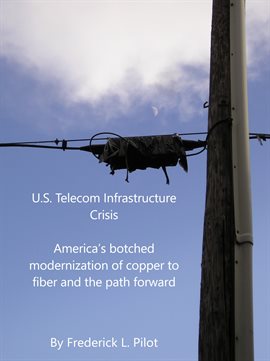
eBook
hoopla Instant
U.S. Telecom Infrastructure Crisis
Year
2020
Language
ENGLISH
Publication Information
BookBaby
Summary
In 2020 as public health restrictions due to the COVID-19 pandemic suddenly converted millions of American homes into offices, classrooms and medical clinics, the nation's accumulated deficits in advanced telecommunications infrastructure and related challenges of access and affordability that had been in place for years have now reached a crisis point. The root of the problem is a failure of planning and policy over the past quarter century to ensure decades old copper telephone lines that reach every American doorstep were modernized with fiber optic lines to support Internet delivered digital telecommunications. The nation lacks a comprehensive, coordinated transition plan and relies on various underfunded, piecemeal efforts. The cause of the failure: public policymakers focused on the wrong thing: incremental gains in "broadband" speed instead of replacing the copper with fiber beginning a generation ago. With the enactment of the 1996 Telecommunications Act, policymakers erred in assuming fiber would be just one of several technologies that would compete with copper rather than pursuing a deliberate policy to ensure the timely replacement of copper with fiber. Consequently, fiber reaches less than a third of American homes in 2020. That's far short of the goal of the Federal Communications Commission's National Broadband Plan prepared for Congress in 2010 that called for 100 million homes to have affordable fiber-level connections a decade later. U.S. telecommunications policy primarily serves the needs of for profit companies that lack incentive to rapidly speed construction of fiber to solve America's advanced telecommunications infrastructure deficits. There's an inherent conflict between their investors' focus on short term earnings and the broader public interest of having universally accessible and affordable fiber connections. This book describes how the crisis is affecting people, the factors that brought it about and prolong it, the outlook for its resolution and a path forward: publicly owned, open access fiber infrastructure passing reaching every home as telephone service did in the mid-20th century. The audience for this book is public policymakers, telecommunications regulators and the general public. Members of these groups acknowledge the essential nature of advanced telecommunications infrastructure as a utility. That recognition has grown more urgent over time and especially so with the 2020 coronavirus pandemic and sharply increased reliance on home connectivity and working from home.